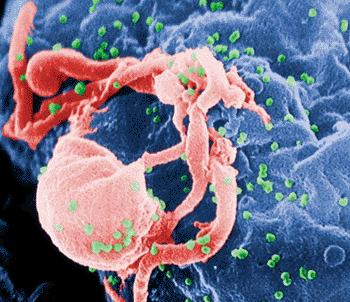Aggressive New HIV Strain Leads to AIDS Faster
By LabMedica International staff writers
Posted on 11 Dec 2013
A new aggressive strain of human immunodeficiency virus (HIV) develops more rapidly into acquired immunodeficiency syndrome (AIDS) than other current strains.Posted on 11 Dec 2013
Human immunodeficiency virus type 1 (HIV-1) is characterized by a high genetic diversity, a consequence of an extremely high replication rate, an error-prone reverse transcriptase, recombination events during replication, and host selective immune pressure. HIV-1 is divided into subtypes and the impact circulating recombinant forms (CRFs) need to be investigated.

Image: Scanning electron micrograph of Human immunodeficiency virus 1 (HIV-1) budding (in green) from cultured lymphocyte (Photo courtesy of C. Goldsmith).
Scientists at the Lund University (Sweden) analyzed blood samples obtained from individuals enrolled in a cohort comprising police officers in Guinea-Bissau. The cohort includes 225 HIV-1 seroincident individuals with estimated dates of seroconversion, defined as the midpoint between the last seronegative and the first seropositive sample. In total, samples were available for 191 individuals.
Viral ribonucleic acid (RNA) was extracted from blood plasma samples amplified by reverse-transcription polymerase chain reaction, and the C2–V3 region (460 bp) sequenced. Clones were amplified using Platinum Taq DNA Polymerase High Fidelity (Invitrogen, Carlsbad, CA, USA) and conventional M13 primers (−20 and −24) and sequenced using primers JA170, JA169 or M13 reverse primer.
The major subtypes/CRFs identified were CRF02_AG (53%), A3 (29%), and A3/02 (a recombinant of A3 and CRF02_AG) (13%). Infection with A3/02 was associated with a close to three-fold increased risk of AIDS and AIDS-related death compared to A3, respectively. The estimated time from seroconversion to AIDS and AIDS-related death was 5 and 8 years for A3/02, 6 and 9 years for CRF02_AG, and 7 and 11 years for A3.
Patrik Medstrand, PhD, professor of Clinical Virology at Lund University, said, “HIV is an extremely dynamic and variable virus. New subtypes and recombinant forms of HIV-1 have been introduced to our part of the world, and it is highly likely that there are a large number of circulating recombinants of which we know little or nothing. We therefore need to be aware of how the HIV-1 epidemic changes over time.” The study was published in the November 2103 issue of the Journal of Infectious Diseases.
Related Links:
Lund University
Invitrogen













